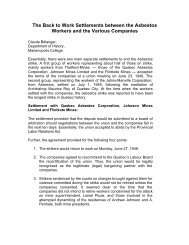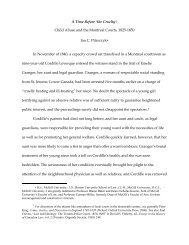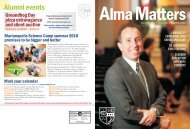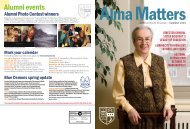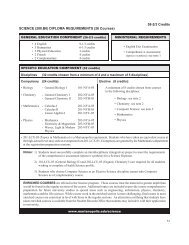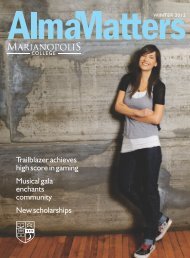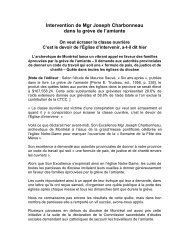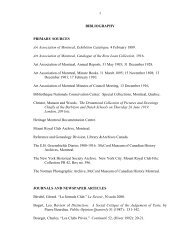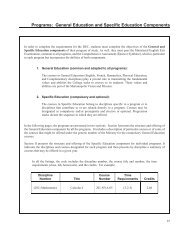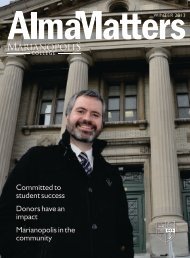Science: Biology - ChemistryBiology (101)The study of biology is concernedwith living organisms, their diversity,evolution, and structure and functionat the cellular and organismal levels.It includes the study of cell metabolism,genetics – Mendelian andmolecular, and biodiversity.General Biology I101-NYA-05 (3-2-3) 2.66 creditsThis course investigates the levels oforganization of living organisms, theirdiversity, evolution and mode of life.Topics discussed include: thestructure and function of cells andcellular organelles; genetic materialand protein synthesis; cell division,Mendelian inheritance and populationgenetics; the origin of life, diversityand physiology of the main taxonomicgroups; Darwin’s theory ofevolution and mechanisms ofspeciation. The global aspects ofliving organisms are presented withecological principles at the level ofthe population, communities andecosystems.General Biology II101-LCU-05 (3-2-3) 2.66 creditsPrerequisite: 101-NYA-05The molecular basis of livingorganisms is discussed in the generalframework of cellular homeostasis.The principle areas of investigationinclude: biochemical structure andfunction of macromolecules; enzymesand enzyme regulation; bioenergeticsof cellular respiration and photosynthesis;DNA replication and proteinsynthesis; regulation of gene expression;bacterial and viral life cycles;recombinant DNA technology;features of the immune system; nervecell function and muscle contraction.54Human Physiology101-LCV-05 (3-2-3) 2.66 credits(Winter term only)Prerequisite: 101-NYA-05This course introduces the studentto human anatomy and physiology.Topics studied include the nervous,digestive, circulatory, respiratory,excretory, reproductive and endocrinesystems. Emphasis is placed on thestructure/function relationship inphysiology. The laboratorycomponent includes histology,computerized measurements ofrespiration and electrocardiogramsas well as dissections.Chemistry (202)Every aspect of modern life involveschemicals from pharmaceuticals toclothing, from food production tohousehold goods. In college courses,students study how substances changeand interact with each other, theirproperties and their characteristics.General Chemistry I202-NYA-05 (3-2-3) 2.66 creditsPrerequisite: Sec. V Chemistry(051504, 551504)This course introduces the moderntheories of the structures of atoms andmolecules, the types of chemical bonding,molecular geometry and the qualitativeand quantitative way in whichchemicals react with each other indifferent types of reactions. Thephysical properties of gases andsolutions are discussed while, in thelaboratory, basic manipulative skillsare taught.General Chemistry II202-NYB-05 (3-2-3) 2.66 creditsPrerequisite: 202-NYA-05The inter-relationship betweenenergy, spontaneity and equilibriumchemistry are studied using thethermodynamic concepts of enthalpy,entropy and free energy changes.Together with an introduction tochemical kinetics, electrochemistryand the chemistry of acids, bases,buffers and solubility, the coursefocuses on the quantitative aspectsof chemical reactions.Organic Chemistry I202-LCU-05 (3-2-3) 2.66 creditsPrerequisite: 202-NYA-05This is an introductory course inOrganic Chemistry and concentrateson the importance of a systematic,mechanistic approach to organicreactions. The physical and chemicalproperties of acyclic and cyclichydrocarbons, alkyl halides andaromatics are studied with anemphasis on isomerism, stereochemistryand synthesis. Thelaboratory work introduces studentsto many of the commonly usedtechniques including distillation,reflux and chromatography.Organic Chemistry II202-LCV-05 (3-2-3) 2.66 credits(Winter term only)Prerequisite: 202-LCU-05Synthesis of organic compounds,mechanisms of reactions and analysisof structure by chemical and spectroscopicmethods are the major areasconcentrated on in this course. Thefamilies of compounds studied includeethers, aldehydes, alcohols, ketones,amines, as well as carboxylic acidsand their derivatives.
Science: Computer Science - MathematicsComputer Science(420)Mastery of computers has become anessential part of many branches ofscience, technology, commerce, andthe arts. Computer scientists may beinvolved with circuit design, programming,problem solving, or projectplanning. Computer users mayproduce documents, performcommercial computations, or keeptrack of masses of information usingstandard business packages. Usingspecialized software, they may solveequations or plot curves; they maydesign web pages, advertisements orindustrial parts.Computer Programming420-LCU-05 (3-2-3) 2.66 credits(Winter Term only)This course introduces students to aprogramming language, such as C++or Java, which is widely used byprofessional programmers and inuniversities. Material coveredincludes: standard programmingconstructs, introduction to objectorientedprogramming, problemsolvingtechniques, programorganization and documentation,introduction to objects, classes,abstract data types. Emphasis is onproject development and organization,as well as introduction to generallyuseful programming techniques andto a variety of applications.The course is generally taught as alecture course with sessions in theComputer Lab. Students are expectedto complete programming projects ontheir own, in the Computer Lab andat home.Technical Drawing420-LCV-05 (3-2-3) 2.66 credits(Winter Term only)This course is an introduction to solidmodeling and industrial drafting, usinga computer-aided design packagesuch as Solid Edge. It is aimed atpotential engineers, architects, andanyone else needing to producetechnical drawings. Only basiccomputer literacy is assumed.The course covers elements ofcomputer-aided design, includingviews, projections, dimensioning,standard drawing elements and theirmeanings, 3-D modeling techniques,and working drawings. Studentsproduce designs and workingdrawings from given sketches andviews, as well as designing objectson their own.The course involves some drawing byhand, as well as extensive hands-onuse of the design software in theComputer Lab, both in class and forstudents working on their own.Programming Techniques andApplications420-LCW-MS (3-2-3) 2.66 creditsThis is a second-level programmingcourse, covering parts of a universityleveldata structures course. Studentscompleting this course might obtainadvanced placement in a universityprogram in computer science or arelated engineering field.It is assumed that the student isfamiliar with the elements of the C++or Java language up to and includingarrays, user-defined functions, enumeratedtypes, as well as techniquesof classical structured programming.Students go beyond this to coverrecursion, dynamic data allocation,linked lists, depth-first search, trees,and some sorting techniques.Students are expected to completeprogramming projects, working partlyduring scheduled lab time and partlyon their own. Each project includesprogram design as well as codingand testing.Mathematics (201)Mathematics is both a subject of studyin its own right and an indispensabletool in the study of all other branchesof Science.Reasonable proficiency in the theoryand application of Mathematics isrequired for entry to all universityundergraduate programs in theHealth Sciences, Pure and AppliedSciences, Commerce and ComputerScience.Topics in Mathematics201-LCX-05 (3-2-3) 2.66 creditsPrerequisite:Sec. V Math TS (064506, 564506), orSec. V Math SN (065506, 565506)Students with an enriched mathbackground and who have taken anequivalent course at the high-schoollevel may seek an exemption from201-LCX-05. Exemptions are grantedindividually before registration.This course covers material whichprepares for and complements allscience mathematics coursesincluding:201-NYA-05201-NYB-05201-NYC-05201-LCU-05201-LCV-05201-LCW-05201-LCY-05201-LCZ-MSContent: Topics in analytic geometry;topics in trigonometry; algebra ofcomplex numbers; polynomials over55
- Page 2 and 3:
VISIONMarianopolis College, drawing
- Page 4 and 5:
GENERAL INFORMATION: Introduction t
- Page 6 and 7: AdmissionsOUT-OF-PROVINCEAPPLICANTS
- Page 8 and 9: Financial Information• Birks Fami
- Page 10 and 11: Financial InformationConfirmation F
- Page 12 and 13: Academic Information• Failure (EC
- Page 14 and 15: Academic InformationThose who are a
- Page 16 and 17: Rules and Regulationsand whether su
- Page 18 and 19: EDUCATIONAL RESOURCES & SERVICESAss
- Page 20 and 21: Educational Resources and ServicesS
- Page 22 and 23: CHOOSING A PROGRAMDiploma Programs
- Page 24 and 25: CertificatesSpecial InterestCertifi
- Page 26 and 27: Programs: General Education and Spe
- Page 28 and 29: General EducationGENERAL EDUCATION
- Page 30 and 31: General Education: Englishidentifyi
- Page 32 and 33: General Education: Englishas the fi
- Page 34 and 35: General Education: Englishintended
- Page 36 and 37: General Education: Frenchand curren
- Page 38 and 39: General Education: Frenchce cours t
- Page 40 and 41: General Education: HumanitiesHumani
- Page 42 and 43: General Education: Humanitiesunders
- Page 44 and 45: General Education: Humanitiespracti
- Page 46 and 47: General Education: Humanitiespracti
- Page 48 and 49: General Education: Physical Educati
- Page 50 and 51: General Education: ComplementaryCom
- Page 52 and 53: General Education: ComplementaryMod
- Page 54 and 55: SECTSpecificEducation Component- Sc
- Page 58 and 59: Science: Mathematics - PhysicsR and
- Page 60 and 61: 56-2/3 to 58 CreditsSOCIAL SCIENCE
- Page 62 and 63: Social Science: Profiles - General
- Page 64 and 65: Social Science: Psychology ProfileE
- Page 66 and 67: Social Science: Law, Society and Ju
- Page 68 and 69: Social Science: Honours CommerceHon
- Page 70 and 71: Social Science: Anthropology - Biol
- Page 72 and 73: Social Science: History - Mathemati
- Page 74 and 75: Social Science: Political Sciencedi
- Page 76 and 77: Social Science: Religion - Sociolog
- Page 78 and 79: 54-2/3 CreditsCREATIVE ARTS, LITERA
- Page 80 and 81: Creative Arts, Literature and Langu
- Page 82 and 83: Creative Arts, Literature and Langu
- Page 84 and 85: Creative Arts, Literature and Langu
- Page 86 and 87: Creative Arts, Literature and Langu
- Page 88 and 89: Creative Arts, Literature and Langu
- Page 90 and 91: Creative Arts, Literature and Langu
- Page 92 and 93: 58-2/3 CreditsMUSIC (501.A0) DIPLOM
- Page 94 and 95: MusicEar Training and Theory IV551-
- Page 96 and 97: 59-1/3 CreditsARTS AND SCIENCES (70
- Page 98 and 99: Arts and Sciences: English - Humani
- Page 100 and 101: Arts and Sciences: Art History - Ar
- Page 102 and 103: Arts and Sciences: Mathematics - Mu
- Page 104 and 105: Arts and Sciences: Multidisciplinar
- Page 106 and 107:
56-2/3 to 58 CreditsLIBERAL ARTS (7
- Page 108 and 109:
Liberal Artsof evolution; the first
- Page 110 and 111:
Liberal ArtsOptionalIn addition to
- Page 112 and 113:
Teaching FacultyFLEISCHER, George T
- Page 114 and 115:
Teaching FacultyTRILLER, Bernice Sh
- Page 116:
INDEX II: Programs and CoursesGener



